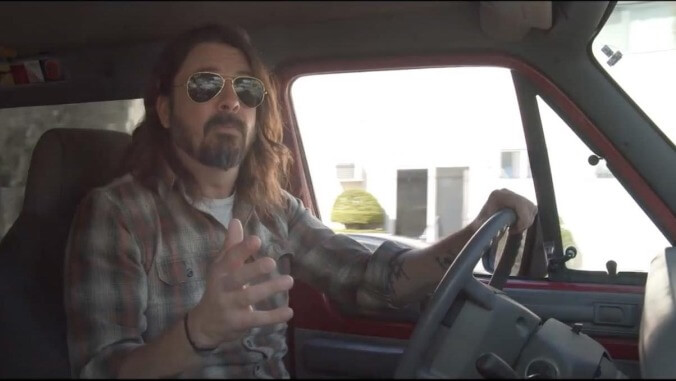Dave Grohl gets a bunch of famous musicians back in the van for What Drives Us


Just about everyone can relate to the need for escape. Especially now, as we (hopefully) approach the end of a calamitous pandemic that has forced many of us to sit patiently in our homes, day in and day out, with no one but ourselves for company. Listening to someone talk about the longing to be somewhere, anywhere else is a relatable driving force of What Drives Us, Dave Grohl’s new documentary. The film takes a “Stars—they’re just like us!” approach, sitting down with famous musicians and letting them hold court on their early days as scrappy, hungry artists just trying to get enough gas in their tanks and food in their stomachs to make it to the next gig. Focusing on that youthful wanderlust gives the film a timelier hook than it would’ve otherwise had (and might explain why it’s being released now, just as there’s light at the end of the no-live-music tunnel), and helps energize a documentary that is otherwise just a bunch of talking heads enjoying the chance to reminisce, mostly (though not entirely) through a thick sheen of nostalgia.
Documentaries about musicians often have a leg up, in that they can answer the question “Couldn’t this have just been an article?” raised by so many nonfiction features. Here, you get one thing that can never be properly captured on the page: the power of live performances. In What Drives Us, there’s a giddy thrill to seeing old footage of St. Vincent, X, No Doubt, Fugazi, Metallica, and others during the earliest stages of their careers, often sounding quite different than they would after becoming famous. (U2’s The Edge has an especially surprising origin story for he and his bandmates, noting that they couldn’t play their instruments at first, and upon seeing The Ramones, all agreed, “Let’s do that, sound like that.”) One of the biggest takeaways from What Drives Us is that Grohl maybe should’ve added even more of this material, as it’s by far the most compelling and distinctive element of his film.
But as anyone who has followed the Foo Fighters frontman over the years can attest, his amiable dad-joke mindset and cornball sensibilities don’t always lead to the most artistically meritorious decision-making. The movie delivers cheesy, upbeat voice-over from the director, continually dropping in to restate things interviewees have said in their own words, or using his own story for inspirational fodder, in ways that sometimes work and sometimes strain credulity. (Much as in Back And Forth, the 2011 Foo Fighters documentary, Grohl’s myth-making about the early days of his band—painting them as nobodies who eked out some hardscrabble life in a van, when he was one of the most famous drummers in the world and the group’s debut went gold within a month—is pretty hard to swallow.) But the artist’s genuine enthusiasm for music remains infectious. It’s a mentality that saturates the film and helps excuse some of the hoarier platitudes, like when he posits, “You can tell a lot about a person by what type of van they drive”—a sentiment anyone who was ever a broke musician, pooling their meager resources to purchase whatever piece of shit vehicle they could afford, might contest.
Grohl’s subjects are, by and large, happy to shoot the shit about their salad days, whether it’s St. Vincent discussing a time when she saw no alternative to climbing into a van and hitting the road, or Metallica’s Lars Ulrich describing how his childhood in Denmark, which included three hours of religious history education every afternoon, spawned an early desire to see the world. Do you know that even The Beatles were once four dorks in a van? Ringo Starr is on call to say as much. Some of the most honest insights come from unexpected places, as when Aerosmith’s Steven Tyler bluntly talks about how success often requires endless nights playing to empty rooms, hoping some magic momentum catches on. (Of course, Tyler also waxes poetic about the joy of seeing audiences sing along to songs you wrote in the studio with your friends, just having fun, before the film cuts to music from Get A Grip, an Aerosmith album largely penned by a team of songwriters. Grohl’s not the only artist in history with a penchant for self-mythologizing.) The film does spend a little time with a pair of younger, lesser-known acts, the three brothers of Radkey and the power-rock group Starcrawler, but their inclusion seems largely symbolic, meant to showcase how little things have changed in the ensuing decades.
The movie makes a few detours en route to its larger portrait of the way music can offer a haven for those looking to get out of their hometowns. Late in the film, Grohl stops everything for a sobering narrative from the Dead Kennedys’ D.H. Peligro about how the racism he experienced on tour contributed to his tailspin into addiction, before he got on the road to recovery. It’s undeniably compelling stuff (and the rare reminder in the movie that traveling in America can often suck) but feels tonally jarring amid the feel-good uplift and light-hearted joking that dominate the proceedings. The film works better as a casual glimpse behind the curtain of big-name acts, exuding a voyeuristic appeal in the footage and anecdotes of beloved musicians opening up about their pasts. It’s breezy fun, if a little forgettable, spending 90 minutes with charismatic performers who have a knack for a good yarn.